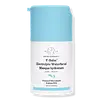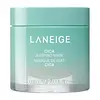What's inside
What's inside
 Key Ingredients
Key Ingredients

 Benefits
Benefits

 Concerns
Concerns

 Ingredients Side-by-side
Ingredients Side-by-side

Water
Skin ConditioningSqualane
EmollientPropanediol
SolventNiacinamide
SmoothingOlive Oil Glycereth-8 Esters
EmollientCoconut Alkanes
EmollientCocos Nucifera Water
MaskingSimmondsia Chinensis Seed Oil
EmollientAmmonium Acryloyldimethyltaurate/Vp Copolymer
Glycerin
HumectantMannitol
HumectantSclerocarya Birrea Seed Oil
HumectantSclerocarya Birrea Seed Butter
EmollientSodium PCA
HumectantOpuntia Tuna Fruit Extract
Skin ConditioningLinum Usitatissimum Seed Oil
PerfumingSorbitol
HumectantQuercetin
AntioxidantTrehalose
HumectantZea Mays Oil
EmulsifyingCetyl Alcohol
EmollientSucrose
HumectantCreatine
Skin ConditioningInositol
HumectantPentylene Glycol
Skin ConditioningFerulic Acid
AntimicrobialHydroxytyrosol
BleachingBehenic Acid
CleansingLinoleic Acid
CleansingCholesterol
EmollientCeramide Ns
Skin ConditioningCeramide AP
Skin ConditioningCeramide Eos
Skin ConditioningCeramide NP
Skin ConditioningCeramide EOP
Skin ConditioningPhospholipids
Skin ConditioningSodium Hyaluronate Crosspolymer
HumectantMagnesium PCA
HumectantMicrocrystalline Cellulose
AbsorbentAdenosine
Skin ConditioningSodium Hyaluronate
HumectantXanthan Gum
EmulsifyingCaprooyl Phytosphingosine
Skin ConditioningAscorbyl Palmitate
AntioxidantHydroxypropyl Methylcellulose
Emulsion StabilisingCaprooyl Sphingosine
Skin ConditioningCoco-Caprylate/Caprate
EmollientCeteareth-25
CleansingCitric Acid
BufferingGlyceryl Caprylate
EmollientPhenoxyethanol
PreservativeCaprylyl Glycol
EmollientSodium Benzoate
MaskingTocopherol
AntioxidantChlorphenesin
AntimicrobialPotassium Sorbate
PreservativeEthylhexylglycerin
Skin ConditioningWater, Squalane, Propanediol, Niacinamide, Olive Oil Glycereth-8 Esters, Coconut Alkanes, Cocos Nucifera Water, Simmondsia Chinensis Seed Oil, Ammonium Acryloyldimethyltaurate/Vp Copolymer, Glycerin, Mannitol, Sclerocarya Birrea Seed Oil, Sclerocarya Birrea Seed Butter, Sodium PCA, Opuntia Tuna Fruit Extract, Linum Usitatissimum Seed Oil, Sorbitol, Quercetin, Trehalose, Zea Mays Oil, Cetyl Alcohol, Sucrose, Creatine, Inositol, Pentylene Glycol, Ferulic Acid, Hydroxytyrosol, Behenic Acid, Linoleic Acid, Cholesterol, Ceramide Ns, Ceramide AP, Ceramide Eos, Ceramide NP, Ceramide EOP, Phospholipids, Sodium Hyaluronate Crosspolymer, Magnesium PCA, Microcrystalline Cellulose, Adenosine, Sodium Hyaluronate, Xanthan Gum, Caprooyl Phytosphingosine, Ascorbyl Palmitate, Hydroxypropyl Methylcellulose, Caprooyl Sphingosine, Coco-Caprylate/Caprate, Ceteareth-25, Citric Acid, Glyceryl Caprylate, Phenoxyethanol, Caprylyl Glycol, Sodium Benzoate, Tocopherol, Chlorphenesin, Potassium Sorbate, Ethylhexylglycerin
Water
Skin ConditioningGlycerin
HumectantSqualane
EmollientButylene Glycol
HumectantCetearyl Alcohol
EmollientDicaprylyl Carbonate
Emollient1,2-Hexanediol
Skin ConditioningButylene Glycol Dicaprylate/Dicaprate
EmollientPentaerythrityl Tetraethylhexanoate
EmollientPolyglyceryl-3 Methylglucose Distearate
EmulsifyingHydrogenated Coco-Glycerides
EmollientPolyglyceryl-3 Distearate
EmulsifyingGlyceryl Stearate
EmollientPanthenol
Skin ConditioningAmmonium Acryloyldimethyltaurate/Vp Copolymer
Cetearyl Glucoside
EmulsifyingLactobacillus Ferment
Skin ConditioningPolyacrylate Crosspolymer-6
Emulsion StabilisingLactobacillus Ferment Lysate
Skin ConditioningPropanediol
SolventNiacinamide
SmoothingEthylhexylglycerin
Skin ConditioningGlyceryl Stearate Citrate
EmollientAllantoin
Skin ConditioningSodium Stearoyl Glutamate
CleansingDipotassium Glycyrrhizate
HumectantSodium Metaphosphate
BufferingMadecassoside
AntioxidantEctoin
Skin ConditioningDextrin
AbsorbentTheobroma Cacao Extract
Skin ConditioningBeta-Glucan
Skin ConditioningAsiaticoside
AntioxidantMadecassic Acid
Skin ConditioningAsiatic Acid
Skin ConditioningTocopherol
AntioxidantCentella Asiatica Flower/Leaf/Stem Extract
Skin ConditioningHydrolyzed Vegetable Protein
Skin Conditioning7-Dehydrocholesterol
Emulsion StabilisingInonotus Obliquus Extract
Skin ConditioningWater, Glycerin, Squalane, Butylene Glycol, Cetearyl Alcohol, Dicaprylyl Carbonate, 1,2-Hexanediol, Butylene Glycol Dicaprylate/Dicaprate, Pentaerythrityl Tetraethylhexanoate, Polyglyceryl-3 Methylglucose Distearate, Hydrogenated Coco-Glycerides, Polyglyceryl-3 Distearate, Glyceryl Stearate, Panthenol, Ammonium Acryloyldimethyltaurate/Vp Copolymer, Cetearyl Glucoside, Lactobacillus Ferment, Polyacrylate Crosspolymer-6, Lactobacillus Ferment Lysate, Propanediol, Niacinamide, Ethylhexylglycerin, Glyceryl Stearate Citrate, Allantoin, Sodium Stearoyl Glutamate, Dipotassium Glycyrrhizate, Sodium Metaphosphate, Madecassoside, Ectoin, Dextrin, Theobroma Cacao Extract, Beta-Glucan, Asiaticoside, Madecassic Acid, Asiatic Acid, Tocopherol, Centella Asiatica Flower/Leaf/Stem Extract, Hydrolyzed Vegetable Protein, 7-Dehydrocholesterol, Inonotus Obliquus Extract
 Reviews
Reviews

Ingredients Explained
These ingredients are found in both products.
Ingredients higher up in an ingredient list are typically present in a larger amount.
Ammonium Acryloyldimethyltaurate/Vp Copolymer (let's call it AAVC for short) is a synthetically created polymer. It's used as a film-forming agent and used to thicken the consistency of products.
AAVC is able to increase the consistency and viscosity of products due to its large molecule size. It also prevents ingredients from separating.
Ethylhexylglycerin (we can't pronounce this either) is commonly used as a preservative and skin softener. It is derived from glyceryl.
You might see Ethylhexylglycerin often paired with other preservatives such as phenoxyethanol. Ethylhexylglycerin has been found to increase the effectiveness of these other preservatives.
Glycerin is already naturally found in your skin. It helps moisturize and protect your skin.
A study from 2016 found glycerin to be more effective as a humectant than AHAs and hyaluronic acid.
As a humectant, it helps the skin stay hydrated by pulling moisture to your skin. The low molecular weight of glycerin allows it to pull moisture into the deeper layers of your skin.
Hydrated skin improves your skin barrier; Your skin barrier helps protect against irritants and bacteria.
Glycerin has also been found to have antimicrobial and antiviral properties. Due to these properties, glycerin is often used in wound and burn treatments.
In cosmetics, glycerin is usually derived from plants such as soybean or palm. However, it can also be sourced from animals, such as tallow or animal fat.
This ingredient is organic, colorless, odorless, and non-toxic.
Glycerin is the name for this ingredient in American English. British English uses Glycerol/Glycerine.
Learn more about GlycerinNiacinamide is a multitasking form of vitamin B3 that strengthens the skin barrier, reduces pores and dark spots, regulates oil, and improves signs of aging.
And the best part? It's gentle and well-tolerated by most skin types, including sensitive and reactive skin.
You might have heard of "niacin flush", or the reddening of skin that causes itchiness. Niacinamide has not been found to cause this.
In very rare cases, some individuals may not be able to tolerate niacinamide at all or experience an allergic reaction to it.
If you are experiencing flaking, irritation, and dryness with this ingredient, be sure to double check all your products as this ingredient can be found in all categories of skincare.
When incorporating niacinamide into your routine, look out for concentration amounts. Typically, 5% niacinamide provides benefits such as fading dark spots. However, if you have sensitive skin, it is better to begin with a smaller concentration.
When you apply niacinamide to your skin, your body converts it into nicotinamide adenine dinucleotide (NAD). NAD is an essential coenzyme that is already found in your cells as "fuel" and powers countless biological processes.
In your skin, NAD helps repair cell damage, produce new healthy cells, support collagen production, strengthen the skin barrier, and fight environmental stressors (like UV and pollution).
Our natural NAD levels start to decline with age, leading to slower skin repair, visible aging, and a weaker skin barrier. By providing your skin niacinamide, you're recharging your skin's NAD levels. This leads to stronger, healthier, and younger looking skin.
Another name for vitamin B3 is nicotinamide. This vitamin is water-soluble and our bodies don't store it. We obtain Vitamin B3 from either food or skincare. Meat, fish, wheat, yeast, and leafy greens contain vitamin B3.
The type of niacinamide used in skincare is synthetically created.
Learn more about NiacinamidePropanediol is an all-star ingredient. It softens, hydrates, and smooths the skin.
It’s often used to:
Propanediol is not likely to cause sensitivity and considered safe to use. It is derived from corn or petroleum with a clear color and no scent.
Learn more about PropanediolSqualane is an emollient that helps the skin hold onto moisture. It's an oily liquid that occurs naturally in certain types of fish and plant oils.
Because squalane boosts hydration in the skin, it also comes with plenty of benefits: it is an antioxidant and can help fight free radicals and skin damage. Squalane is also found to have a detoxifying effect when applied.
Squalane comes from squalene, which occurs naturally within the sebum of our skin. It is one of the oils our skin produces to keep itself hydrated. Squalane is the hydrogenated version of squalene and has a longer shelf life.
Research shows that squalane is non-irritating (even at 100% concentration).
In general, it's a fantastic ingredient. It does a great job at hydrating the skin, and it's suitable for those with sensitive skin.
The source of squalane may impact malassezia / fungal acne. This is because olive oil derived squalane can contain impurities such as fatty acids and plant waxes. Sugarcane derived squalane is recommended for anyone with malassezia concerns.
Is squalane vegan?
This depends on the source. Squalane can be derived from both plants and animals. Most squalane used in skincare comes from plants.
Please note: the source of squalane is only known if disclosed by the brand. We recommend reaching out to the brand if you have any questions about their squalane.
Read more about squalene with an "e".
Is squalane an oil?
Squalane is often called an oil, but it’s technically not; it’s a hydrocarbon, meaning it’s only made of carbon and hydrogen, unlike true oils which are triglycerides made of fatty acids and glycerol.
The term “oil-free” isn’t regulated, so companies can define it however they want. Some exclude all oils, while others just avoid mineral oil or comedogenic oils.
While some people avoid oils thinking they cause breakouts, the right kind of oil (or oil-like ingredient like squalane) can actually help balance and hydrate your skin. It’s worth testing out simple oils or squalane to see what works best for your skin.
Learn more about SqualaneTocopherol (also known as Vitamin E) is a common antioxidant used to help protect the skin from free-radicals and strengthen the skin barrier. It's also fat soluble - this means our skin is great at absorbing it.
Vitamin E also helps keep your natural skin lipids healthy. Your lipid skin barrier naturally consists of lipids, ceramides, and fatty acids. Vitamin E offers extra protection for your skin’s lipid barrier, keeping your skin healthy and nourished.
Another benefit is a bit of UV protection. Vitamin E helps reduce the damage caused by UVB rays. (It should not replace your sunscreen). Combining it with Vitamin C can decrease sunburned cells and hyperpigmentation after UV exposure.
You might have noticed Vitamin E + C often paired together. This is because it is great at stabilizing Vitamin C. Using the two together helps increase the effectiveness of both ingredients.
There are often claims that Vitamin E can reduce/prevent scarring, but these claims haven't been confirmed by scientific research.
Learn more about TocopherolWater. It's the most common cosmetic ingredient of all. You'll usually see it at the top of ingredient lists, meaning that it makes up the largest part of the product.
So why is it so popular? Water most often acts as a solvent - this means that it helps dissolve other ingredients into the formulation.
You'll also recognize water as that liquid we all need to stay alive. If you see this, drink a glass of water. Stay hydrated!
Learn more about Water